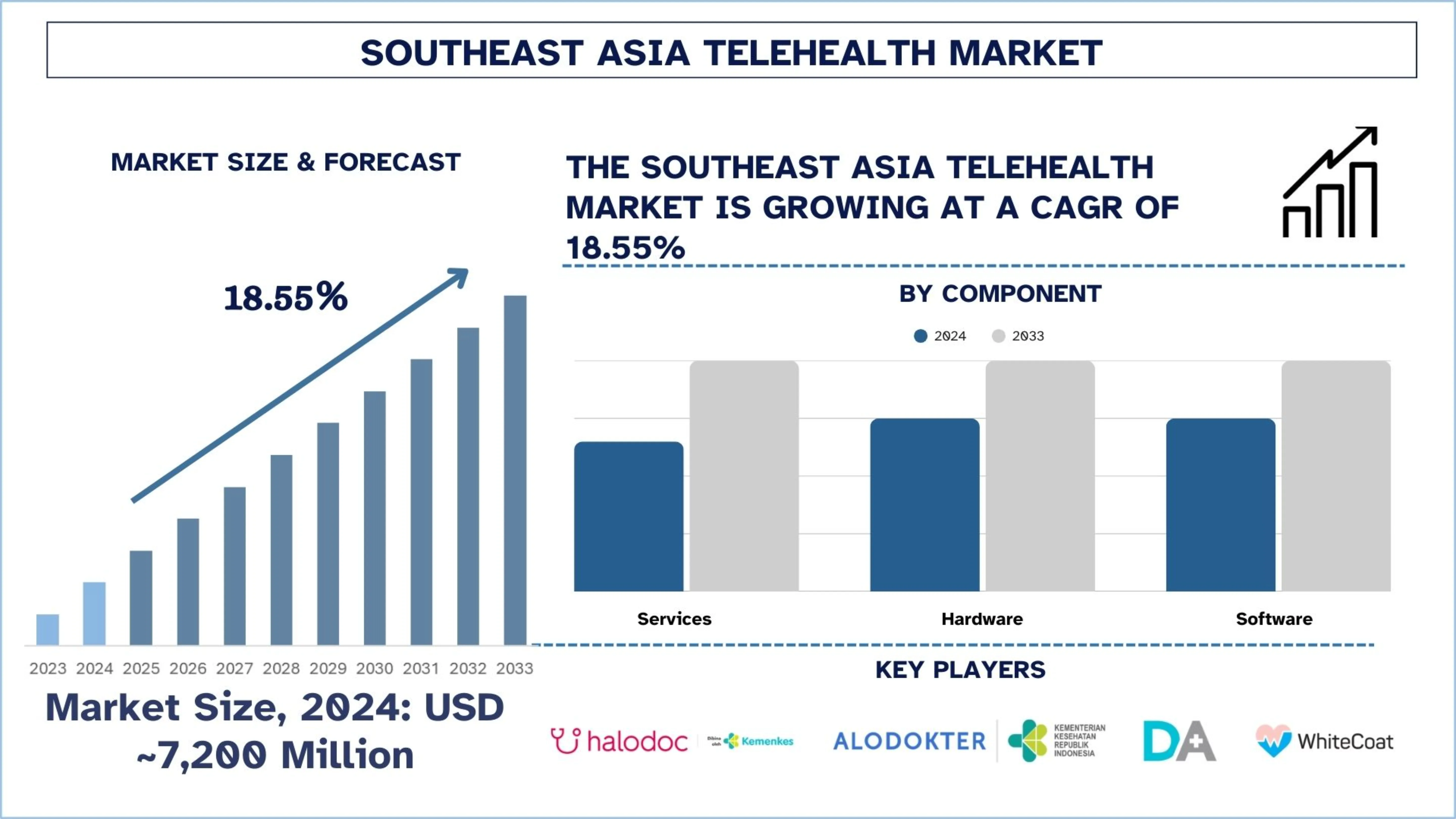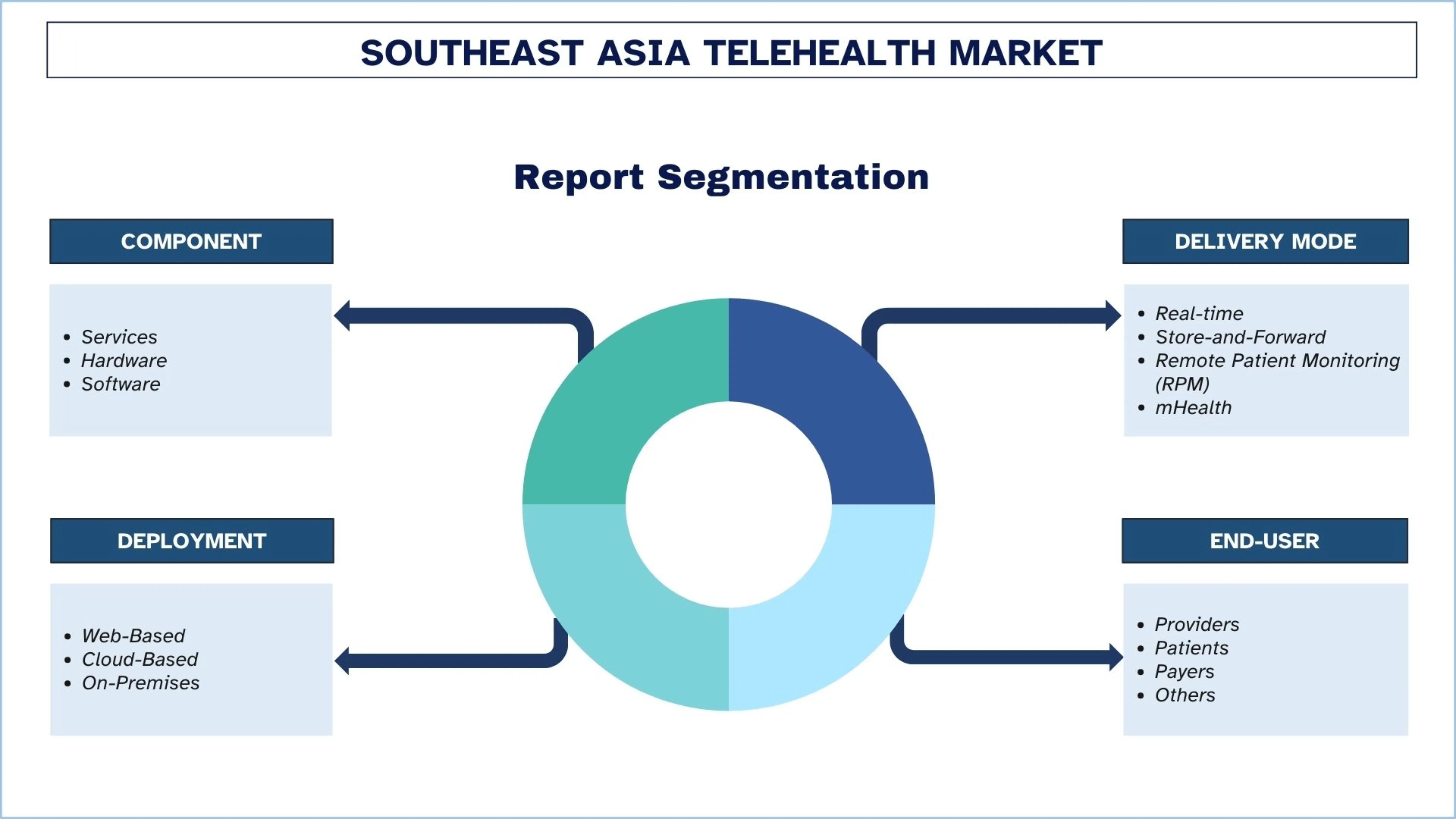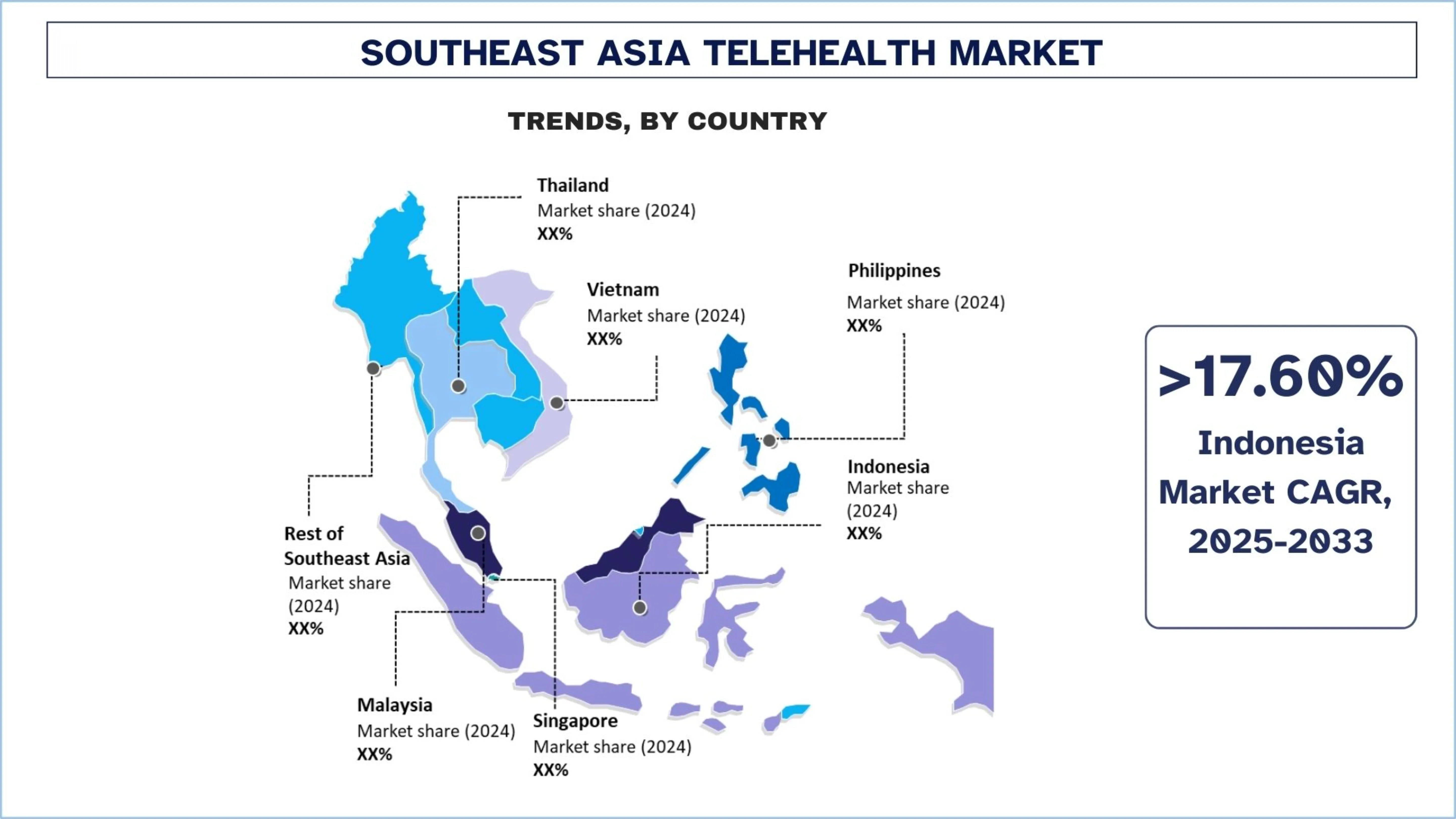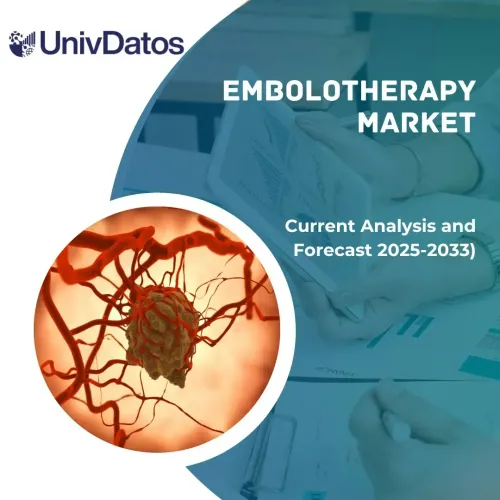- Home
- About Us
- Industry
- Services
- Reading
- Contact Us
Southeast Asia Telehealth Market: Current Analysis and Forecast (2025-2033)
Emphasis on Component (Services, Hardware, Software); Delivery Mode (Real-time, Store-and-Forward, Remote Patient Monitoring (RPM), mHealth); Deployment (Web-based, Cloud-Based, On-Premises); Application (Teleconsultation, Telestroke, Teleradiology, Telepsychiatry, Teledermatology, Others); End-User (Providers, Patients, Payers, Others); and Country.

Southeast Asia Telehealth Market Size & Forecast
The Southeast Asia Telehealth market was valued at USD 7,200 million in 2024 and is expected to grow at a strong CAGR of around 18.55% during the forecast period (2025-2033F), driven by increased awareness and acceptance of digital consultations.
Southeast Asia Telehealth Market Analysis
Telehealth can be defined as the combination of medicine and technology, which allows a doctor to interact with a patient remotely to provide more access to healthcare services, particularly in remote areas.
The rising adoption of telehealth is gaining momentum as patients and providers increasingly use digital platforms to consult with each other, manage chronic illnesses, and seek mental health assistance. Moreover, the surge in the number of funding rounds raised by companies drives the digitalization in healthcare. Additionally, investments are being directed towards serving a broader area, developing scalable cloud-based solutions, and enhancing interoperability with existing healthcare systems. In addition, the advancement of technology is transforming the market through AI-driven triage, remote patient monitoring equipment, and mobile health applications.
On May 1, 2025, Heydoc Health, an emerging leader in digital outpatient care innovation, announced the launch of Malaysia’s first fully integrated digital e-Referral solutions via its flagship telehealth platform, DOC2US. This is a breakthrough in digital care navigation, streamlining patient journeys across clinics, ambulatory care centres, hospitals, and pharmacies with a single, paperless system in Malaysia.

Southeast Asia Telehealth Market Trends
This section discusses the key market trends that are influencing the various segments of the Southeast Asia Telehealth market, as found by our team of research experts.
Integration of AI and Wearables
The rising integration of Artificial Intelligence (AI) and wearables is a major trend in the Southeast Asia telehealth industry. To distinguish customers and improve the interaction with patients, companies are starting to implement smart wearables, AI-based diagnostics, and remote monitoring solutions. It is also a promising trend towards the establishment of smooth, information-driven care ecosystems by tech companies and healthcare providers that are no longer limited to the traditional clinical care environment. For instance, on February 19, 2025, Royal Philips and SingHealth, Singapore’s largest public healthcare cluster, announced a strategic partnership to enhance healthcare delivery through deploying innovative technologies and accelerating the digital transformation of the healthcare landscape in Singapore. With a focus on co-designing and integrating Artificial Intelligence (AI) and predictive data management to improve patient care by 2028.
Southeast Asia Telehealth Industry Segmentation
This section provides an analysis of the key trends in each segment of the Southeast Asia Telehealth market, along with forecasts at the country level for 2025-2033.
The services category held a dominant share of the telehealth market in 2024.
Based on component, the market is segmented into services, hardware, and software. Among these, the services category held a dominant share of the telehealth market in 2024. The adoption is fueled by the services segment, as patients demand convenient, affordable, and accessible healthcare services. In addition, increasing collaborations between digital health technology and specialized providers are making it possible to implement holistic programs for employers and payers, making chronic conditions more accessible and coordinated. For instance, on September 23, 2025, FlyteHealth and Heartbeat Health announced a partnership to introduce a bundled program aimed at integrating cardiometabolic and cardiovascular care through virtual-first solutions. The collaboration focuses on employers and payers, and it provides a single strategy to coordinate such related health conditions.
The provider segment held a dominant share of the market in 2024.
Based on end-user, the Southeast Asian Telehealth market is segmented into providers, patients, payers, and others. Among these, the providers segment held a dominant share of the market in 2024, driven by growing interest among investors in digital healthcare providers in Southeast Asia, with several of them raising multi-million-dollar funding rounds to speed up regional growth, driving the market. The trend underlines high confidence in the scalability of telehealth solutions and their contribution to transforming the nature of employee and patient healthcare. For example, on August 22, 2025, Naluri expanded further across Southeast Asia, which is a digital employee healthcare provider based in Malaysia. It closed an equity fundraising round, securing USD 5 million from TELUS Global Ventures and existing investors, Sumitomo Corporation Equity Asia, and M Venture Partners. This brings the total Series B funding raised to USD 14 million. Naluri offers tailored employee health programmes to enterprise clients in various industries in Malaysia and Indonesia.
Indonesia held a dominant share of the Southeast Asian Telehealth market in 2024
The main driver of telehealth development in Indonesia is the large population and the uneven distribution of healthcare facilities, as digital health technologies are seen as an indispensable measure rather than a choice. The widespread penetration of smartphones and the growing 4G/5G networks enable such extensive access to virtual consultations and mHealth platforms. Government programs, such as eHealth roadmaps and business investment, are facilitating large-scale adoption. The high rate of chronic illness, as well as the necessity of low-cost, accessible healthcare, also contribute to the demand for remote healthcare solutions. All these aspects make Indonesia a market leader, providing businesses with opportunities to achieve scale and long-term revenues. On July 15, 2025, the Indonesian Ministry of Health and Royal Philips entered into a partnership for long-term health system transformation. They signed a memorandum of understanding that aims to enhance the Indonesian health system's resilience and enable more equitable access to high-quality care. Digital health was identified as one of the three key focus areas of their collaboration. They seek to integrate digital technologies across the health system "to enhance service quality, strengthen system integration, and improve operational efficiency nationwide."

Southeast Asia Telehealth Industry Competitive Landscape
The Southeast Asia Telehealth market is competitive, with several global and international market players. The key players are adopting different growth strategies to enhance their market presence, such as partnerships, agreements, collaborations, new product launches, geographical expansions, and mergers and acquisitions.
Top Southeast Asia Telehealth Companies
Some of the major players in the market are PT Media Dokter Investama and Affiliates (Halodoc), Alodokter, Doctor Anywhere, WhiteCoat Holdings Pte Ltd., Health Digital Technologies Sdn Bhd (DoctorOnCall), SeeYouDoc Corp, Viettel, Medgate, MaNaDr Pte Ltd, and Koninklijke Philips N.V.
Recent Developments in the Southeast Asia Telehealth Market
On October 11, 2024, WhiteCoat Global, Asia’s leading digital healthcare provider, announced the acquisition of Good Doctor Indonesia (“Good Doctor”), the telemedicine platform with the largest insurer and corporate client network in Indonesia. This landmark deal will create the region’s largest and most comprehensive digital healthcare group that works with over 130 insurers and 7,500 corporate partners to provide care to over 6.8 million insured lives.
On March 3, 2023, Alodokter, an Indonesia-based digital health platform, launched Alni, a chat-based virtual assistant for doctors. Alni has been developed since 2018 using data gathered from teleconsultations on the platform and feedback from doctors. Alni uses conversational AI to prescreen patients through a series of questions and provides prediagnosis recommendations to Alodokter’s telemedicine doctors.
Southeast Asia Telehealth Market Report Coverage
Report Attribute | Details |
Base year | 2024 |
Forecast period | 2025-2033 |
Growth momentum | Accelerate at a CAGR of 18.55% |
Market size 2024 | USD 7,200 Million |
Country analysis | Indonesia, Thailand, Philippines, Vietnam, Malaysia, Singapore, Rest of Southeast Asia |
Major contributing Country | Vietnam is expected to grow at the highest CAGR during the forecasted period. |
Companies profiled | PT Media Dokter Investama and Affiliates (Halodoc), Alodokter, Doctor Anywhere, WhiteCoat Holdings Pte Ltd., Health Digital Technologies Sdn Bhd (DoctorOnCall), SeeYouDoc Corp, Viettel, Medgate, MaNaDr Pte Ltd, Koninklijke Philips N.V. |
Report Scope | Market Trends, Drivers, and Restraints; Revenue Estimation and Forecast; Segmentation Analysis; Demand and Supply Side Analysis; Competitive Landscape; Company Profiling |
Segments Covered | By Component, By Delivery Mode, By Deployment, By Application, By End-user, By Country |
Reasons to Buy the Southeast Asia Telehealth Market Report:
The study includes market sizing and forecasting analysis confirmed by authenticated key industry experts.
The report briefly reviews overall industry performance at a glance.
The report covers an in-depth analysis of prominent industry peers, primarily focusing on key business financials, product portfolios, expansion strategies, and recent developments.
Detailed examination of drivers, restraints, key trends, and opportunities prevailing in the industry.
The study comprehensively covers the market across different segments.
Customization Options:
The Southeast Asia Telehealth market can further be customized as per requirements or any other market segment. Besides this, UnivDatos understands that you may have your own business needs; hence, feel free to contact us to get a report that completely suits your requirements.
Table of Content
Research Methodology for the Southeast Asia Telehealth Market Analysis (2023-2033)
We analyzed the historical market, estimated the current market, and forecasted the future market of the Southeast Asian Telehealth market to assess its application in major countries. We conducted exhaustive secondary research to gather historical market data and estimate the current market size. To validate these insights, we carefully reviewed numerous findings and assumptions. Additionally, we conducted in-depth primary interviews with industry experts across the Southeast Asian Telehealth value chain. After validating market figures through these interviews, we used both top-down and bottom-up approaches to forecast the overall market size. We then employed market breakdown and data triangulation methods to estimate and analyze the market size of industry segments and sub-segments.
Market Engineering
We employed the data triangulation technique to finalize the overall market estimation and derive precise statistical numbers for each segment and sub-segment of the Southeast Asia Telehealth market. We split the data into several segments and sub-segments by analyzing various parameters and trends, including component, delivery mode, deployment, application, end-user, and country within the Southeast Asian Telehealth market.
The Main Objective of the Southeast Asia Telehealth Market Study
The study identifies current and future trends in the Southeast Asia Telehealth market, providing strategic insights for investors. It highlights market attractiveness, enabling industry participants to tap into untapped markets and gain a first-mover advantage. Other quantitative goals of the studies include:
Market Size Analysis: Assess the current and forecast market size of the Southeast Asia Telehealth market and its segments in terms of value (USD).
Southeast Asia Telehealth Market Segmentation: Segments in the study include areas of component, delivery mode, deployment, application, end-user, and country.
Regulatory Framework & Value Chain Analysis: Examine the regulatory framework, value chain, customer behavior, and competitive landscape of the Southeast Asia Telehealth industry.
Country Analysis: Conduct a detailed country analysis for key areas such as Indonesia, Thailand, the Philippines, Vietnam, Malaysia, Singapore, and the Rest of Southeast Asia.
Company Profiles & Growth Strategies: Company profiles of the Southeast Asia Telehealth market and the growth strategies adopted by the market players to sustain in the fast-growing market.
Frequently Asked Questions FAQs
Q1: What is the Southeast Asia Telehealth market’s current market size and growth potential?
The Southeast Asia Telehealth market was valued at USD 7,200 million in 2024 and is projected to expand at a CAGR of 18.55% from 2025 to 2033, driven by strong digital adoption, rising chronic disease prevalence, and increased government support.
Q2: Which segment has the largest share of the Southeast Asia Telehealth market by component?
The services segment dominates the market, driven by continuous virtual consultations, telepharmacy, remote patient monitoring, and digital follow-ups, which enhance recurring revenue streams and patient engagement.
Q3: What are the driving factors for the growth of the Southeast Asia Telehealth market?
Key growth drivers include increasing internet and smartphone penetration, rising demand for remote healthcare, government initiatives supporting digital health, expansion of employer wellness programs, and the integration of AI and wearable devices for personalized care.
Q4: What are the emerging technologies and trends in the Southeast Asia Telehealth market?
Prominent trends include AI-powered diagnostics, tele-psychiatry, mobile health applications, remote patient monitoring, and the integration of wearables with predictive analytics. These innovations are improving accessibility, patient engagement, and the efficiency of virtual care delivery.
Q5: What are the key challenges in the Southeast Asia Telehealth market?
The market faces challenges such as data privacy and cybersecurity concerns, regulatory inconsistencies across countries, limited digital literacy among certain populations, infrastructure constraints in rural regions, and integration hurdles with existing healthcare systems.
Q6: Which country dominates the Southeast Asia Telehealth market?
Indonesia currently leads the market, driven by its large population, rising digital health adoption, supportive regulatory frameworks, and increasing demand for virtual healthcare solutions in both urban and rural areas.
Q7: Who are the key players in the Southeast Asia Telehealth market?
Leading companies in the Southeast Asia Telehealth market include:
• PT Media Dokter Investama and Affiliates (Halodoc)
• Alodokter
• Doctor Anywhere
• WhiteCoat Holdings Pte Ltd.
• Health Digital Technologies Sdn Bhd (DoctorOnCall)
• SeeYouDoc Corp
• Viettel
• Medgate
• MaNaDr Pte Ltd
• Koninklijke Philips N.V.
Q8: What investment opportunities exist in the Southeast Asia Telehealth market?
Investment opportunities include funding AI-driven telehealth platforms, expanding tele-pharmacy services, developing remote monitoring solutions for chronic diseases, targeting rural healthcare markets, and partnering with employers for corporate wellness programs.
Q9: How can businesses leverage telehealth to gain a competitive advantage in Southeast Asia?
Companies can adopt integrated virtual care solutions, invest in AI and wearable technologies, collaborate with local providers, and design patient-centric services to enhance accessibility, improve outcomes, and differentiate themselves in a rapidly growing market.
Related Reports
Customers who bought this item also bought










